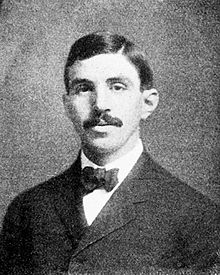Edward Kasner (April 2, 1878 – January 7, 1955) was an American mathematician who was appointed Tutor on Mathematics in the Columbia University Mathematics Department. Kasner was the first Jewish person appointed to a faculty position in the sciences at Columbia University.[1] Subsequently, he became an adjunct professor in 1906, and a full professor in 1910, at the university. Differential geometry was his main field of study. In addition to introducing the term "googol", he is known also for the Kasner metric and the Kasner polygon.[2]
Edward Kasner | |
|---|---|
 Kasner in 1907 | |
| Born | April 2, 1878 New York City, U.S. |
| Died | January 7, 1955 (aged 76) New York City, U.S. |
| Alma mater | City College of New York (BA) Columbia University (MA, PhD) |
| Known for | Kasner metric Kasner polygon Apollonian gasket "Googol" |
| Awards | Colloquium Lecture (1909) |
| Scientific career | |
| Fields | Mathematics |
| Institutions | Columbia University |
| Doctoral advisor | Felix Klein David Hilbert |
| Doctoral students | Rufus Isaacs Joseph Ritt Jesse Douglas Edna Kramer |
Education
editKasner's 1899 PhD dissertation at Columbia University was titled The Invariant Theory of the Inversion Group: Geometry upon a Quadric Surface; it was published by the American Mathematical Society in 1900 in their Transactions.
Googol and googolplex
editKasner is perhaps best remembered today for introducing the term "googol." In order to pique the interest of children, Kasner sought a name for a very large number: one followed by 100 zeros. On a walk in the New Jersey Palisades with his nephews, Milton (1911–1981)[3] and Edwin Sirotta, Kasner asked for their ideas. Nine-year-old Milton suggested "googol".[4]
In 1940, with James R. Newman, Kasner co-wrote a non-technical book surveying the field of mathematics, called Mathematics and the Imagination (ISBN 0-486-41703-4). It was in this book that the term "googol" was first popularized:
Words of wisdom are spoken by children at least as often as by scientists. The name "googol" was invented by a child (Dr. Kasner's nine-year-old nephew) who was asked to think up a name for a very big number, namely, 1 with a hundred zeros after it. He was very certain that this number was not infinite, and therefore equally certain that it had to have a name. At the same time that he suggested "googol" he gave a name for a still larger number: "Googolplex." A googolplex is much larger than a googol, but is still finite, as the inventor of the name was quick to point out. It was suggested that a googolplex should be 1, followed by writing zeros until you get tired. This is a description of what would happen if one actually tried to write a googolplex, but different people get tired at different times and it would never do to have Carnera a better mathematician than Dr. Einstein, simply because he had more endurance. The googolplex then, is a specific finite number, with so many zeros after the 1 that the number is a googol. A googolplex is much bigger than a googol. You will get some idea of the size of this very large but finite number from the fact that there would not be enough room to write it, if you went to the farthest star, touring all the nebulae and putting down zeros every inch of the way.
— [5]
The Internet search engine "Google" originated from a misspelling of "googol",[6][7][8] and the "Googleplex" (the Google company headquarters in Mountain View, California) is similarly derived from googolplex.
Personal life
editKasner was Jewish and was the son of Austrian immigrants.[9]
Works
edit- Kasner, E. (1900). "The Invariant Theory of the Inversion Group: Geometry Upon a Quadric Surface". Transactions of the American Mathematical Society. 1 (4): 430–498. doi:10.1090/S0002-9947-1900-1500550-1. hdl:2027/miun.abv0510.0001.001. JSTOR 1986367.
- Kasner, Edward (1980) [1934]. "Differential-geometric aspects of dynamics". In C. Carpelan; A. Parpola; P. Koskikallio (eds.). The Logarithmic potential and other monographs. New York: Chelsea. pp. 235–263. ISBN 0-8284-0305-8.
- Kasner, Edward; Newman, James R. (April 2001) [London: Penguin, 1940; New York: Simon and Schuster, 1967]. Mathematics and the Imagination. Dover Pubns. ISBN 0-486-41703-4.
- Edward Kasner and James R. Newman, Mathematics and the Imagination, Tempus Books of Microsoft Press, 1989. ISBN 1-55615-104-7
- Kasner, Edward (July 1914). "The Ratio of the Arc to the Chord of an Analytic Curve Need Not Be Unity". Bulletin of the American Mathematical Society. 20 (10): 524–31. doi:10.1090/S0002-9904-1914-02545-5.
- Kasner, Edward (1921). "Geometrical theorems on Einstein's cosmological equations". Amer. J. Math. 43 (4). The Johns Hopkins University Press: 217–221. Bibcode:1921AmJM...43..217K. doi:10.2307/2370192. JSTOR 2370192.
References
edit- ^ Columbia and the "Jewish Problem"
- ^ Douglas, Jesse (1958) Edward Kasner, A Biographical Memoir prepared for the National Academy of Sciences.
- ^ There have been several dates reported in the literature, ranging from 1911 to 1929, but only 1911 is consistent with family records (Bialik).
- ^ Bialik, Carl (June 14, 2004). "There Could Be No Google Without Edward Kasner". The Wall Street Journal Online. (retrieved March 17, 2015)
- ^ Kasner, Edward; Newman, James R. (1989), Mathematics and the Imagination, Tempus Books of Microsoft Press, p. 23, ISBN 1-55615-104-7
- ^ Koller, David. "Origin of the name, "Google" Archived 2012-06-27 at the Wayback Machine, Stanford University January 2004.
- ^ Hanley, Rachael. "From Googol to Google: Co-founder returns Archived December 14, 2006, at the Wayback Machine", The Stanford Daily February 12, 2003 (retrieved July 14, 2006).
- ^ Bylund, Anders. "To Google or Not to Google", The Motley Fool via MSNBC. July 5, 2006 (retrieved July 7, 2006).
- ^ "Edward Kasner". MacTutor.